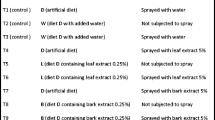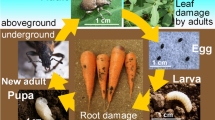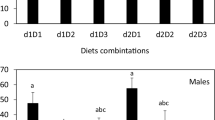Abstract
In order to develop methods for mass rearing of the parasitic wasp Lariophagus distinguendus, we characterized and identified chemicals used by this parasitoid to recognize wheat grains infested by its host, larvae of the granary weevil, Sitophilus granarius, a major pest of stored grain worldwide. Bioassays revealed that drumming and drilling behavior of the parasitoids on grain models of filter paper treated with host feces was as intense as on host-infested grains. Thus, chemicals from feces are highly important to recognize infested grains. Extracts of the feces with hexane or dichloromethane applied on grain models were able to provoke drumming and drilling activity. Hexane extract of feces was as active as infested grain itself. Subsequent fractionation of the hexane extract by adsorption chromatography revealed that highest activity was recovered in the dichloromethane fraction. This fraction was characterized by the presence of α-tocopherol, β-tocopherol, β-tocotrienol, cholesterol, ergostenol, and β-sitosterol. Synthetic chemicals in proportions found in the active dichloromethane fraction stimulated drumming behavior in bioassays. The significance of these results with respect to the mass propagation of L. distinguendus as natural enemies for the control of the granary weevil is discussed.
Similar content being viewed by others
REFERENCES
Agelopoulos, N. G., Dicke, M., and Posthumus, M. A. 1995. Role of volatile infochemicals emitted by feces of larvae in host-searching behavior of parsitoid Cotesia rubecula (Hymenoptera: Braconidae): A behavioral and chemical study. J. Chem. Ecol. 21:1789–1811.
Alborn, H. T., Lewis, W. J., and Tumlinson, J. H. 1995. Host-specific recognition kairomone for the parasitoid Microplitis croceipes (Cresson). J. Chem. Ecol. 21:1697–1708.
Ambriz, S. J., Strand, M. R., and Burkholder, W. E. 1996. Behavioral response of the parasitoid Lariophagus distinguendus (Först) (Hymenoptera: Pteromalidae) to extracts from cocoons of Lasioderma serricorne Fab. (Coleoptera: Anobiidae) and their effects on subsequent oviposition responses. Biol. Control 6:51–56.
Bewley, J. D., and Black, M. 1994. Seeds. Plenum Press, New York.
Bratti, A., and Coulibaly, A. K. 1995. In vitro rearing of Exorista larvarum on tissue culturebased diets. Entomol. Exp. Appl. 74:47–53.
Brower, J. H., Smith, L., Vail, P. V., and Flinn, P. W. 1996. Biological control, pp. 224–285, in B. Subramanyam and D. W. Hagstrum (eds.). Integrated Management of Insects in Stored Products. Marcel Dekker, New York.
Dool, J. Van Den, and Kratz, P. D. 1963. A generalization of the retention index system including linear programmed gas-liquid partition chromatography. J. Chromatogr. 11:463.
Greany, P. 1986. In vitro culture of hymenopterous larval endoparasitoids. J. Insect Physiol. 32:409–419.
Gross, H. R., Lewis, W. J., Jones, R. L., and Nordlund, D. A. 1975. Kairomones and their use for management of entomophagous insects: III. Stimulation of Trichogramma achaeae, T. pretiosum, and Microplitis croceipes with host-seeking stimuli at time of release to improve their efficiency. J. Chem. Ecol. 1:431–438.
Hase, A. 1924. Zur Kenntnis wirtschaftlich wichtiger Tierformen. I. Über den Stech-und Legeakt, sowie über den Wirtswechsel von Lariophagus distinguendus. Chalcididae. Pteromalini. Naturwissenschaften 12:377–384.
Hendry, L. B., Greany, P. D., and Gill, R. J. 1973. Kairomone mediated host-finding behavior of the parasitic wasp Orgilus lepidus. Entomol. Exp. Appl. 16:471–477.
Henson, R. D., Vinson, S. B., and Barfield, C. S. 1977. Ovipositional behavior of Bracon mellitor Say (Hymenoptera: Braconidae), a parasitoid of boll weevil (Anthonomus grandis Boh.). III. Isolation and identification of natural releasers of ovipositor probing. J. Chem. Ecol. 3:151–158.
Hu, J. S., and Vinson, S. B. 1997. In vitro rearing of Campoletis sonorensis, a larval endoparasitoid of Heliothis virescens from egg to third instar in an artificial medium devoid of insect sources. Entomol. Exp. Appl. 75:263–273.
Klein-Tebbe, J., Jeep, S., Josties, C., MEYSEL, U., O'Connor, A., and Kunkel, G. 1992. IgEmediated inhalant allergy in inhabitants of a building infested by rice weevil (Sitophilus oryzae). Ann. Allergy 69:497–504.
Lewis, W. J., Tumlinson, J. H., and Krasnoff, S. 1991. Chemically mediated associative learning: An important function in the foraging behavior of Microplitis croceipes (Cresson). J. Chem. Ecol. 17:1309–1325.
Mudd, A., Walters, J. H. H., and Corbet, S. A. 1984. Relative kairomonal activities of 2-acylcylclohexane-1,3-diones in eliciting oviposition behavior from parasite Nemeritis canescens (Grav.) J. Chem. Ecol. 10:1597–1601.
Nuhn, P. 1997. Naturstoffchemie. S. Hirzel Verlag, Stuttgart.
Richards, O. W., and Oxley, T. A. 1943. The ejection of frass by larvae of Calandra (Col., Curculionidae) under the influence of CO2. Proc. R. Soc. London (A) 18:22–24.
Rojas, M. G., Morales-Ramos, J. A., and King, E. G. 1996. In vitro rearing of the boll weevil (Coleoptera: Curculionidae) ectoparasitoid Catolaccus grandis (Hymenoptera: Pteromalidae) on meridic diets. J. Econ. Entomol. 89:1095–1104.
Rutledge, C. E. 1996. A survey of identified kairomones and synonomes used by insect parasitoids to locate and accept their hosts. Chemoecology 7:121–131.
Sachs, L. 1992. Angewandte Statistik. Springer, Berlin.
Souci, S. W., Fachmann, W., and Kraut, H. 1994. Food Composition and Nutrition Tables. Medpharm, Stuttgart.
Steidle, J. L. M. 1998a. The biology of Lariophagus distinguendus: A natural enemy of stored product pests and potential candidate for biocontrol. IPSP IOBC Bull. 21:103–109.
Steidle, J. L. M. 1998b. Learning pays off: Influence of experience on host finding and parasitism in Lariophagus distinguendus (Hymenoptera: Pteromalidae). Ecol. Entomol. 23:451–456.
Steidle, J. L. M. 2000. Host recognition cues of the granary weevil parasitoid Lariophagus distinguendus. Entomol. Exp. Appl. 95:185–192.
Steidle, J. L. M., and SchÖller, M. 1997. Olfactory host location and learning in the granary weevil parasitoid Lariophagus distinguendus (Hymenoptera: Pteromalidae). J. Insect Behav. 10:331–342.
Steidle, J. L. M., and SchÖller, M. 2000. Fecundity and ability of the parasitoid Lariophagus distinguendus (Hymenoptera: Pteromalidae) to parasitize larvae of the granary weevil Sitophilus granarius (Coleoptera: Curculionidae) in bulk grain. J. Stored Prod. Res. (in press).
Svoboda, J. A., and Thompson, M. J. 1985. Steroids, pp. 137–175, in G. A. Kerkut and L. I. Gilbert (eds.). Comprehensive Insect Physiology Biochemistry and Pharmacology, Vol. 10: Biochemistry. Pergamon Press, Oxford.
Takabayashi, J., and Takahashi, S. 1989. Effects of host fecal pellet and synthetic kairomone on host-searching and post-oviposition behaviour of Apanteles kariyai, a parasitoid of Pseudaletia separata. Entomol. Exp. Appl. 52:221–227.
Takahashi, S., Haijka, M., Takabayashi, J., and Fukui, M., 1980. Oviposition stimulants in the coccoid cuticular waxes of Aphytis yanonesis DeBach and Rosen. Entomol. Exp. Appl. 52:221–227.
Turlings, T. C. J., Tumlinson, J. H., Eller, F. J., and Lewis, W. J. 1991. Larval-damaged plants: Sources of volatile synomones that guide the parasitoid Cotesia marginiventris to the microhabitat of its hosts. Entomol. Exp. Appl. 58:75–82.
Vinson, S. B. 1991. Chemical signals used by parasitoids. Redia 74:15–42.
Vinson, S. B., Henson, R. D., and Barfield, C. S. 1976. Ovipositional behavior of Bracon mellitor Say (Hymenoptera: Braconidae), a parasitoid of boll weevil (Anthonomus grandis Boh.). I. Isolation and identification of a synthetic releaser of ovipositor probing. J. Chem. Ecol. 2:431–440.
Author information
Authors and Affiliations
Rights and permissions
About this article
Cite this article
Steidle, J.L.M., Ruther, J. Chemicals Used for Host Recognition by the Granary Weevil Parasitoid Lariophagus distinguendus. J Chem Ecol 26, 2665–2675 (2000). https://doi.org/10.1023/A:1026473323079
Issue Date:
DOI: https://doi.org/10.1023/A:1026473323079




